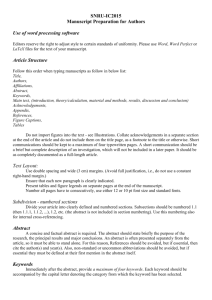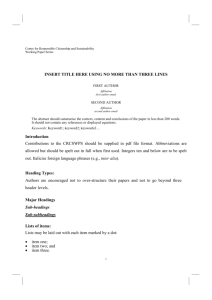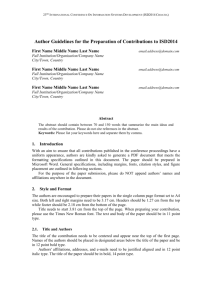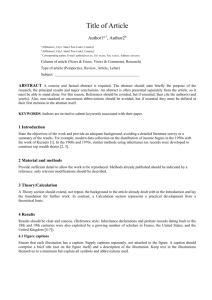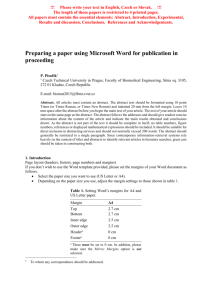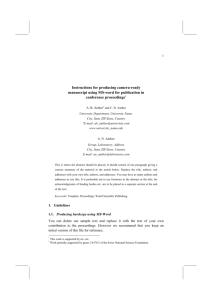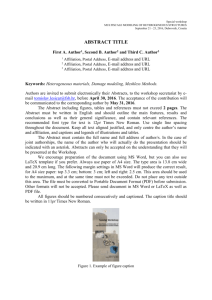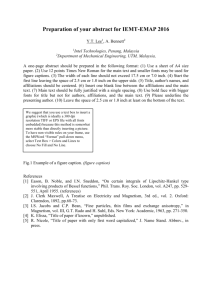the guidelines for full paper submission in
advertisement
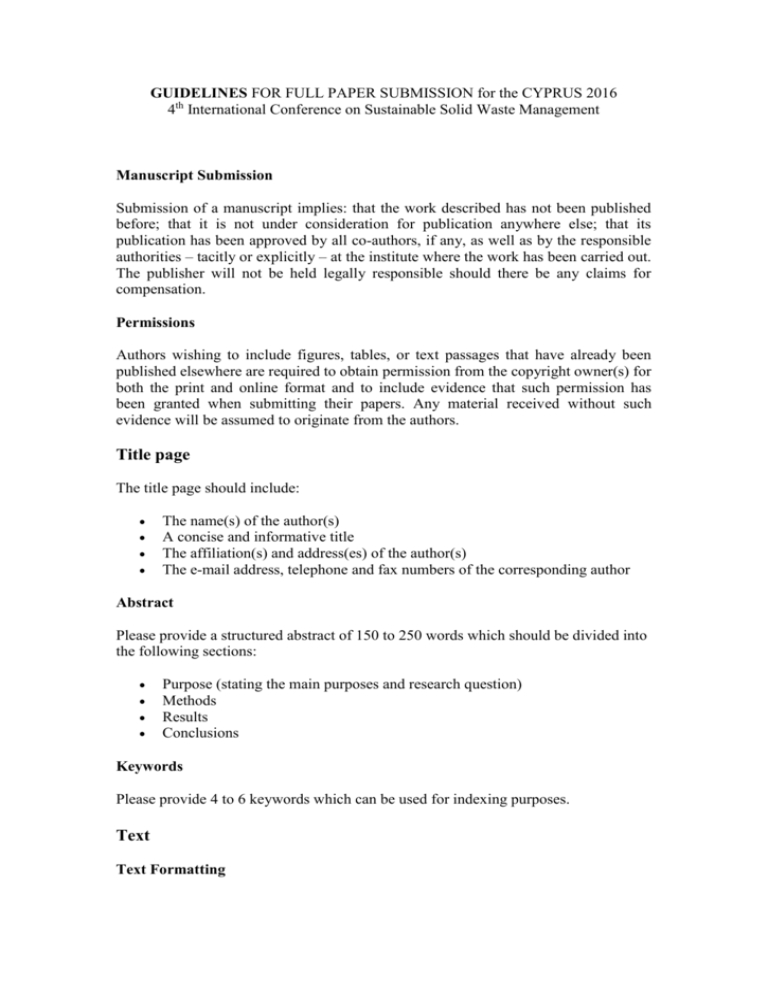
GUIDELINES FOR FULL PAPER SUBMISSION for the CYPRUS 2016 4th International Conference on Sustainable Solid Waste Management Manuscript Submission Submission of a manuscript implies: that the work described has not been published before; that it is not under consideration for publication anywhere else; that its publication has been approved by all co-authors, if any, as well as by the responsible authorities – tacitly or explicitly – at the institute where the work has been carried out. The publisher will not be held legally responsible should there be any claims for compensation. Permissions Authors wishing to include figures, tables, or text passages that have already been published elsewhere are required to obtain permission from the copyright owner(s) for both the print and online format and to include evidence that such permission has been granted when submitting their papers. Any material received without such evidence will be assumed to originate from the authors. Title page The title page should include: The name(s) of the author(s) A concise and informative title The affiliation(s) and address(es) of the author(s) The e-mail address, telephone and fax numbers of the corresponding author Abstract Please provide a structured abstract of 150 to 250 words which should be divided into the following sections: Purpose (stating the main purposes and research question) Methods Results Conclusions Keywords Please provide 4 to 6 keywords which can be used for indexing purposes. Text Text Formatting Manuscripts should be submitted in Word. Use a normal, plain font (e.g., 10-point Times Roman) for text. Use italics for emphasis. Use the automatic page numbering function to number the pages. Do not use field functions. Use tab stops or other commands for indents, not the space bar. Use the table function, not spreadsheets, to make tables. Use the equation editor or MathType for equations. Save your file in docx format (Word 2007 or higher) or doc format (older Word versions). Manuscripts with mathematical content can also be submitted in LaTeX. LaTeX macro package (zip, 182 kB) Headings Please use no more than three levels of displayed headings. Abbreviations Abbreviations should be defined at first mention and used consistently thereafter. Footnotes Footnotes can be used to give additional information, which may include the citation of a reference included in the reference list. They should not consist solely of a reference citation, and they should never include the bibliographic details of a reference. They should also not contain any figures or tables. Footnotes to the text are numbered consecutively; those to tables should be indicated by superscript lower-case letters (or asterisks for significance values and other statistical data). Footnotes to the title or the authors of the article are not given reference symbols. Always use footnotes instead of endnotes. Acknowledgments Acknowledgments of people, grants, funds, etc. should be placed in a separate section before the reference list. The names of funding organizations should be written in full. References Citation Reference citations in the text should be identified by numbers in square brackets. Some examples: 1. Negotiation research spans many disciplines [3]. 2. This result was later contradicted by Becker and Seligman [5]. 3. This effect has been widely studied [1-3, 7]. Reference list The list of references should only include works that are cited in the text and that have been published or accepted for publication. Personal communications and unpublished works should only be mentioned in the text. Do not use footnotes or endnotes as a substitute for a reference list. The entries in the list should be numbered consecutively. Journal article Hamburger, C.: Quasimonotonicity, regularity and duality for nonlinear systems of partial differential equations. Ann. Mat. Pura Appl. 169, 321–354 (1995) Article by DOI Sajti, C.L., Georgio, S., Khodorkovsky, V., Marine, W.: New nanohybrid materials for biophotonics. Appl. Phys. A (2007). doi:10.1007/s00339-0074137-z Book Geddes, K.O., Czapor, S.R., Labahn, G.: Algorithms for Computer Algebra. Kluwer, Boston (1992) Book chapter Broy, M.: Software engineering — from auxiliary to key technologies. In: Broy, M., Denert, E. (eds.) Software Pioneers, pp. 10–13. Springer, Heidelberg (2002) Online document Cartwright, J.: Big stars have weather too. IOP Publishing PhysicsWeb. http://physicsweb.org/articles/news/11/6/16/1 (2007). Accessed 26 June 2007 Always use the standard abbreviation of a journal’s name according to the ISSN List of Title Word Abbreviations, see www.issn.org/2-22661-LTWA-online.php For authors using EndNote, Springer provides an output style that supports the formatting of in-text citations and reference list. EndNote style (zip, 2 kB) Tables All tables are to be numbered using Arabic numerals. Tables should always be cited in text in consecutive numerical order. For each table, please supply a table caption (title) explaining the components of the table. Identify any previously published material by giving the original source in the form of a reference at the end of the table caption. Footnotes to tables should be indicated by superscript lower-case letters (or asterisks for significance values and other statistical data) and included beneath the table body. Artwork and Illustrations Guidelines For the best quality final product, it is highly recommended that you submit all of your artwork – photographs, line drawings, etc. – in an electronic format. Your art will then be produced to the highest standards with the greatest accuracy to detail. The published work will directly reflect the quality of the artwork provided. Electronic Figure Submission Supply all figures electronically. Indicate what graphics program was used to create the artwork. For vector graphics, the preferred format is EPS; for halftones, please use TIFF format. MS Office files are also acceptable. Vector graphics containing fonts must have the fonts embedded in the files. Name your figure files with "Fig" and the figure number, e.g., Fig1.eps. Line Art Definition: Black and white graphic with no shading. Do not use faint lines and/or lettering and check that all lines and lettering within the figures are legible at final size. All lines should be at least 0.1 mm (0.3 pt) wide. Scanned line drawings and line drawings in bitmap format should have a minimum resolution of 1200 dpi. Vector graphics containing fonts must have the fonts embedded in the files. Halftone Art Definition: Photographs, drawings, or paintings with fine shading, etc. If any magnification is used in the photographs, indicate this by using scale bars within the figures themselves. Halftones should have a minimum resolution of 300 dpi. Combination Art Definition: a combination of halftone and line art, e.g., halftones containing line drawing, extensive lettering, color diagrams, etc. Combination artwork should have a minimum resolution of 600 dpi. Color Art Color art is free of charge for online publication. If black and white will be shown in the print version, make sure that the main information will still be visible. Many colors are not distinguishable from one another when converted to black and white. A simple way to check this is to make a xerographic copy to see if the necessary distinctions between the different colors are still apparent. If the figures will be printed in black and white, do not refer to color in the captions. Color illustrations should be submitted as RGB (8 bits per channel). Figure Lettering To add lettering, it is best to use Helvetica or Arial (sans serif fonts). Keep lettering consistently sized throughout your final-sized artwork, usually about 2–3 mm (8–12 pt). Variance of type size within an illustration should be minimal, e.g., do not use 8-pt type on an axis and 20-pt type for the axis label. Avoid effects such as shading, outline letters, etc. Do not include titles or captions within your illustrations. Figure Numbering All figures are to be numbered using Arabic numerals. Figures should always be cited in text in consecutive numerical order. Figure parts should be denoted by lowercase letters (a, b, c, etc.). If an appendix appears in your article and it contains one or more figures, continue the consecutive numbering of the main text. Do not number the appendix figures, "A1, A2, A3, etc." Figures in online appendices (Electronic Supplementary Material) should, however, be numbered separately. Figure Captions Each figure should have a concise caption describing accurately what the figure depicts. Include the captions in the text file of the manuscript, not in the figure file. Figure captions begin with the term Fig. in bold type, followed by the figure number, also in bold type. No punctuation is to be included after the number, nor is any punctuation to be placed at the end of the caption. Identify all elements found in the figure in the figure caption; and use boxes, circles, etc., as coordinate points in graphs. Identify previously published material by giving the original source in the form of a reference citation at the end of the figure caption. Figure Placement and Size When preparing your figures, size figures to fit in the column width. For most journals the figures should be 39 mm, 84 mm, 129 mm, or 174 mm wide and not higher than 234 mm. For books and book-sized journals, the figures should be 80 mm or 122 mm wide and not higher than 198 mm. Permissions If you include figures that have already been published elsewhere, you must obtain permission from the copyright owner(s) for both the print and online format. Please be aware that some publishers do not grant electronic rights for free and that Springer will not be able to refund any costs that may have occurred to receive these permissions. In such cases, material from other sources should be used. Accessibility In order to give people of all abilities and disabilities access to the content of your figures, please make sure that All figures have descriptive captions (blind users could then use a text-tospeech software or a text-to-Braille hardware) Patterns are used instead of or in addition to colors for conveying information (color-blind users would then be able to distinguish the visual elements) Any figure lettering has a contrast ratio of at least 4.5:1 The full papers should be submitted by email to Dr. Konstantinos Moustakas (konmoust@central.ntua.gr). The deadline for full paper submission is 30th April 2015.
